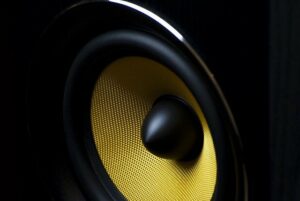The perturbation imposed to cause the back and forth motion of the object is said to be vibratory motion.
These vibrations are carried in the surrounding molecules and the molecules get energy and oscillate to and fro. The motion of the vibrating objects is about a fixed point. Lets us discuss some of the vibratory motion examples listed here below:-
Spring
The spring is an elastic object and has stored potential energy. Upon pressing or stretching the spring, it starts to vibrate to and fro. This is because on compressing or elongating the spring, the spring potential energy is generated which is converted into the kinetic energy on releasing the force incident on the spring.
Tuning Fork
Upon hammering the tuning fork it vibrates at its frequency. This vibrational energy generated is carried by the air molecules in the surroundings and hence the sound wave frequency created is transferred to the listener’s ears.
Depending upon the prong length, each fork produces the vibrational frequencies at a different level and hence it is also used by the musicians.
Guitar Strings
As the guitarist plucks the string on the guitar, it vibrates and produces a pleasant sound of a note.

The vibrating string produces a sound of the same frequency till it comes to a rest or changed the frequency of the vibrating string by playing another note bringing it to rest.
Vibrating Blade on the Edge of the Table
On keeping one end of the blade on the edge of the table, applying the pressure on the other end of the blade, and releasing the pressure, it will start vibrating at a certain frequency.
Object Moving on a Rough Surface
While the object is moving on the rough surface, the frictional force is exerted on the surface of the object that is in contact with the rough surface that is responsible to resist the motion of the object.

The frictional force will produce the vibrational pattern in the object, thus generating heat energy.
Drilling
On passing the electric current to the drilling machine, the drilling rod on the machine will start rotating producing the vibratory motion too due to the acceleration of the drilling rod.
Sawing
While sawing the wood or metal, the sharp edge of the seesaw rubs across the cross-sectional area of the object that is being cut.

Due to the rubbing of surfaces, the frictional force comes into the picture that resists the motion of the seesaw across the object. Some energy is lost in the form of vibrational energy.
Talking
While talking there is a vibration in the vocals.

The vibrations generated in the vocals travel through the molecules in the air generating the sound waves. Thus the vibrational energy is transferred into the sound energy in the medium.
Drumming
As the force is applied to the drum, it starts vibrating thus producing sound.

This vibrational energy is transferred in the air, and the molecules in the air oscillate back and forth transferring the energy for as long as it is possible. This vibration pattern reaches the eardrum and we are able to hear the sound of a drum.
Swing
The swing is attached to a point fixed on the stationary pole from where the swing oscillates. While the swing is in motion, there is frictional force acting on the point of extension due to which the vibratory motion comes into the picture. The tensional force is also developed along the length of the swing.
Playing Music on a Cell Phone
While playing the audio on the mobile, the vibrations due to audio waves are produced. If you touch the mobile phone your hand will receive vibrations. These vibrations are grasped by the molecules in the surrounding air and the audio wave reaches the listener’s ear.
Woofer
The woofer of the loudspeaker oscillates to and fro giving out the audio waves.

The vibratory motion of the woofer is produced due to the magnetic force imposed on the woofer. If you hold your hand in front of the woofer you will feel the pressure of the magnetic and audio waves emerging from the vibrating woofer.
Utensils
When you bang the utensils it will produce a vibratory motion. Depending upon the modulus of elasticity, every object produces a different sound. The vibratory motion of the object produces sound.
Generator
The generators are used for various purposes like converting mechanical energy to electrical energy. You must have realized that as soon as you turn on the generator, you can hear an unpleasant sound generated from the generator. This is due to the vibratory motion from the generator due to the motors and the motion of the conductor in the magnetic field.
Earthquake
As the seismic wave approaches the Earth’s surface, there is a vibratory motion of the ground.
There are many accidents, road slides, and building collapse due to these vibrations. We commonly say that the Earth shakes due to seismic activities. The magnitude and intensity of the Earthquake is the maximum at the point of origin of these seismic waves.
Stretching Rope
Upon stretching the rope, the rope oscillates forming a single loop of waves. The tensional force is built across the length of the rope on stretching due to which the rigidity of the rope changes and it starts vibrating.
Hitting on a Bowl of Water
If you take water in the bowl and touch the bowl with a small rod, you will notice the formation of concentric circles of water in the bowl.

The vibrations given to the bowl are carried by the volume of water thus the waves produce travel on the surface of the water.
Two Objects Colliding
Upon hitting the two objects together, the kinetic energy will be converted into vibrational energy, and this vibrational energy is converted into sound energy as the vibrational energy is grasped by the molecules in the surrounding.
Bell
If you hold a bell in your hand and let it ring, you can feel the vibrational motion of the bell by your hand.
Upon collision, the bell produces the vibrational motion and hence the vibrational motion gives the sound.
Flowing Tap Water
The vibratory motion of the object held under the flowing tap water is seen often. Due to the flow of water, the object will undergo pressure with the imposing energy of water which is converted into vibratory energy.
Frequently Asked Questions
Why do electronic devices produce vibrations?
You must have noticed that many electronic devices produce vibrations.
This is due to the flow of charges in the electronic components and the other oscillatory parts used in the devices.
Why do two objects vibrate upon a collision?
Many objects vibrated upon hitting other rigid objects.
This depends on the modulus of elasticity of the two colliding objects, the kinetic and potential energy will be transformed into the vibrational energy.
Also Read:
- Periodic motion examples
- What is amplitude of motion
- Lens for capturing emotions
- Horizontal motion examples
- Multiple motion examples
- Repetitive motion examples
- Example of relative motion
- Passive range of motion examples
- Curvilinear motion examples
- Lens for capturing fast motion
Hi, I’m Akshita Mapari. I have done M.Sc. in Physics. I have worked on projects like Numerical modeling of winds and waves during cyclone, Physics of toys and mechanized thrill machines in amusement park based on Classical Mechanics. I have pursued a course on Arduino and have accomplished some mini projects on Arduino UNO. I always like to explore new zones in the field of science. I personally believe that learning is more enthusiastic when learnt with creativity. Apart from this, I like to read, travel, strumming on guitar, identifying rocks and strata, photography and playing chess.